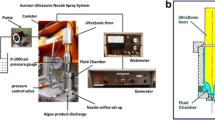Abstract
The disintegration of Nannochloropsis oculata cells in a turbine-stirred bead mill with an ultrasonic system was investigated. The effect of ultrasonic assistance on the suspension viscosity and the percentage of cell disintegration of N. oculata in the disintegration process are discussed. The results show that ultrasonic assistance has a significant effect on the viscosity reduction of N. oculata suspension in the disintegration process, resulting in an increase in the disintegration efficiency. The effective disintegration can be obtained under optimum condition (i.e., ultrasonic power of 100 W, ultrasonic time interval of 5 s, and disintegration time of 30 min). In addition, the disintegration behaviors with and without ultrasonic assistance were also simulated by population balance modeling (PBM). Based on the simulated results, ultrasonic assistance during disintegration process can increase the disruption efficiency of N. oculata cells and the cells are mainly disrupted by compression and shear effects in the mill.






Similar content being viewed by others
References
Abramov VO, Abramova AV, Bayazitov VM, Mullakaev MS, Marnosov AV, Ildiyakov AV (2017) Acoustic and sonochemical methods for altering the viscosity of oil during recovery and pipeline transportation. Ultrason Sonochem 35:389–396
Anandarajah K, Mahendraperumal G, Sommerfeld M, Hu Q (2012) Characterization of microalga Nannochloropsis sp. mutants for improved production of biofuels. Appl Energy 96:371–377
Austin LG (2004) A preliminary simulation model for fine grinding in high speed hammer mills. Powder Technol 143-144:240–252
Beacham TA, Bradley C, White DA, Bond P, Ali ST (2014) Lipid productivity and cell wall ultrastructure of six strains of Nannochloropsis: implications for biofuel production and downstream processing. Algal Res 6:64–69
Berthiaux H, Varinot C, Dodds J (1996) Approximate calculation of breakage parameters from batch grinding tests. Chem Eng Sci 51:4509–4516
Borowitzka MA (2016) Algal physiology and large-scale outdoor cultures of microalgae. In: Borowitzka MA, Beardall J, Raven JA (eds) The physiology of microalgae. Springer, Dordrecht, pp 601–635
Chisti Y, Moo-Young M (1986) Disruption of microbial cells for intracellular products. Enzym Microb Technol 8:194–204
Doucha J, Lívanský K (2008) Influence of processing parameters on disintegration of Chlorella cells in various types of homogenizers. Appl Microbiol Biotechnol 81:431–440
Gerken HG, Donohoe B, Knoshaug EP (2013) Enzymatic cell wall degradation of Chlorella vulgaris and other microalgae for biofuels production. Planta 237:239–253
Gil M, Luciano E, Arauzo I (2015) Population balance model for biomass milling. Powder Technol 276:34–44
Grimi N, Dubois A, Marchal L, Jubeau S, Lebovka NI, Vorobiev E (2014) Selective extraction from microalgae Nannochloropsis sp. using different methods of cell disruption. Bioresour Technol 153:254–259
Günerken E, D'Hondt E, Eppink MHM, Garcia-Gonzalez L, Elst K, Wijffels RH (2015) Cell disruption for microalgae biorefineries. Biotechnol Adv 33:243–260
Halim R, Harun R, Danquah MK, Webley PA (2012) Microalgal cell disruption for biofuel development. Appl Energy 91:116–121
Huang G, Chen F, Wei D, Zhang X, Chen G (2010) Biodiesel production by microalgal biotechnology. Appl Energy 87:38–46
Iida Y, Tuziuti T, Yasui K, Towata A, Kozuka T (2008) Control of viscosity in starch and polysaccharide solutions with ultrasound after gelatinization. Innov Food Sci Emerg 9:140–146
Kandilian R, Lee E, Pilon L (2013) Radiation and optical properties of Nannochloropsis oculata grown under different irradiances and spectra. Bioresour Technol 137:63–73
Kapur PC, Agrawal PK (1970) Approximate solutions to the discretized batch grinding equation. Chem Eng Sci 25:1111–1113
Mitra M, Patidar SK, Mishra S (2015) Integrated process of two stage cultivation of Nannochloropsis sp. for nutraceutically valuable eicosapentaenoic acid along with biodiesel. Bioresour Technol 193:363–369
Pan Z, Huang Y, Wang Y, Wu Z (2017) Disintegration of Nannochloropsis sp. cells in an improved turbine bead mill. Bioresour Technol 245:641–648
Reid KJ (1965) A solution to the batch grinding equation. Chem Eng Sci 20:953–963
Scholz MJ, Weiss TL, Jinkerson RE, Jing J, Roth R, Goodenough U, Posewitz MC, Gerken HG (2014) Ultrastructure and composition of the Nannochloropsis gaditana cell wall. Eukaryot Cell 13:1450–1464
Schütte H, Kula MR (1991) Pilot- and process-scale techniques for cell disruption. Biotechnol Appl Biochem 12:599–620
Schwede S, Kowalczyk A, Gerber M, Span R (2011) Influence of different cell disruption techniques on mono digestion of algal biomass. World Renewable Energy Congress - Bioenergy Technology (BE)-Sweden, pp. 41–7
Spiden E, Scales P, Kentish S, Martin G (2014) Critical analysis of quantitative indicators of cell disruption applied to Saccharomyces cerevisiae processed with an industrial high pressure homogenizer. Biochem Eng J 70:120–126
Toma M, Vinatoru M, Paniwnyk L, Mason TJ (2001) Investigation of the effects of ultrasound on vegetal tissues during solvent extraction. Ultrason Sonochem 8:137–142
Wu PF, Teng JC, Lin YH, Hwang S-CJ (2013) Increasing algal biofuel production using Nannocholropsis oculata cultivated with anaerobically and aerobically treated swine wastewater. Bioresour Technol 133:102–108
Zheng H, Yin J, Gao Z, Huang H, Ji X, Dou C (2011) Disruption of Chlorella vulgaris cells for the release of biodiesel-producing lipids: a comparison of grinding, ultrasonication, bead milling, enzymatic lysis, and microwaves. Appl Biochem Biotechnol 164:1215–1224
Funding
This work was supported by the Funding of Guangdong Science and Technology Department, China (No. 2015A020209019).
Author information
Authors and Affiliations
Corresponding author
Electronic supplementary material
ESM 1
(DOCX 50 kb)
Rights and permissions
About this article
Cite this article
Liu, X., Pan, Z. & Wang, Y. Ultrasound-assisted turbine bead milling for disintegration of Nannochloropsis oculata cells. J Appl Phycol 31, 1651–1659 (2019). https://doi.org/10.1007/s10811-018-1702-0
Received:
Revised:
Accepted:
Published:
Issue Date:
DOI: https://doi.org/10.1007/s10811-018-1702-0




